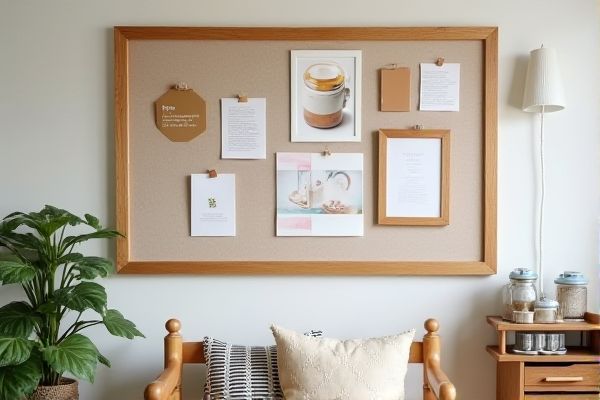
A wall grid offers a versatile and modern way to organize and display items with its open, metal framework, while a bulletin board provides a traditional, solid surface ideal for pinning notes and papers securely. Explore the pros and cons of each to find the best solution for your space and organizational needs.
Table of Comparison
| Feature | Wall Grid | Bulletin Board |
|---|---|---|
| Material | Metal wire grid | Cork or fabric surface |
| Purpose | Display photos, notes with clips | Pin or tack papers and notices |
| Durability | Long-lasting, rust-resistant options | May wear with repeated pinning |
| Style | Modern, minimalist aesthetic | Classic, traditional look |
| Installation | Mounted with screws or hooks | Mounted or free-standing options |
| Maintenance | Easy to clean, no surface damage | Requires surface replacement over time |
| Best for | Decor, organization, flexible arrangement | Notice boards, memos, office use |
Introduction to Wall Grids and Bulletin Boards
Wall grids offer a modern, open framework made of metal or wire, designed for flexible display and organization in homes or offices. Bulletin boards consist of a solid surface, often cork or fabric, used for pinning notes, photos, or reminders in a stationary format. Both serve as functional tools for visual organization but differ in style, material, and versatility.
Design and Aesthetic Differences
Wall grids offer a modern, minimalistic design with an open, geometric framework that enhances visual organization and allows easy customization using clips and hooks. Bulletin boards provide a more traditional, solid surface, often covered in fabric or cork, lending a classic, tactile aesthetic ideal for pinning paper notes and photos. The choice between the two depends on whether a sleek, contemporary look or a warm, conventional feel better complements the room's decor.
Material and Durability Comparison
Wall grids are typically made of steel or metal wire, offering superior durability and resistance to bending or damage compared to bulletin boards, which are often constructed from cork or foam materials. The metal construction of wall grids ensures longevity and maintains their shape under heavy use, while bulletin boards may show wear and tear, such as curling or crumbling edges over time. Choosing a wall grid enhances your space with a robust and long-lasting display solution that withstands frequent pinning and rearranging.
Installation and Setup Requirements
Wall grids typically require mounting hooks or brackets for installation, making them suitable for versatile placement and easy rearrangement without permanent damage. Bulletin boards often need screws, nails, or adhesive strips, requiring more precise measurements and wall preparation to ensure secure attachment and durability. Your choice depends on whether you prefer a more flexible setup with minimal wall impact or a stable, fixed display surface.
Functionality for Organization
Wall grids offer versatile functionality for organization by allowing you to customize arrangement with hooks, clips, and shelves, making them ideal for dynamic and frequently changing displays. Bulletin boards provide a traditional surface for pinning notes, reminders, and important documents, ensuring clear visibility and quick access to essential information. Choosing between the two depends on whether your organization needs prioritize flexibility or straightforward message display.
Customization and Flexibility
Wall grids offer superior customization and flexibility compared to traditional bulletin boards, allowing you to easily rearrange hooks, shelves, and clips to suit changing needs. Their modular design supports varied configurations to display notes, photos, and essentials in personalized layouts. Bulletin boards typically provide a fixed surface primarily for pinning paper items, limiting creative arrangement and multifunctional use.
Space Efficiency and Usage
Wall grids maximize space efficiency by utilizing vertical areas with customizable compartments for organizing tools, notes, or decor, fitting in small or crowded spaces. Bulletin boards offer a simpler, flat surface ideal for pinning papers and reminders but often require more wall width to accommodate multiple items. Your choice depends on whether you need versatile storage or straightforward display functionality in limited spaces.
Cost Comparison
Wall grids typically offer a more cost-effective solution compared to traditional bulletin boards, as they are often made from lightweight metal and provide versatile display options without the need for additional materials. Bulletin boards can incur higher expenses due to their bulky design, cork or fabric surfaces, and accessories like pins or tacks that require frequent replacement. Your budget will benefit from choosing wall grids if you prioritize affordability combined with flexible organization and display capabilities.
Ideal Use Cases for Each Option
Wall grids are ideal for organizing office supplies, displaying photos, or creating a customizable visual arrangement in modern workspaces and creative studios. Bulletin boards excel in environments requiring frequent pinning of notices, memos, and important documents, making them perfect for classrooms, community centers, and offices with high communication needs. Your choice depends on whether you need flexible, decorative display options or a traditional, practical tool for sharing information.
Choosing the Right Option for Your Space
Wall grids offer a modern, flexible display solution ideal for small spaces and dynamic arrangements, allowing easy attachment of photos, notes, and accessories with clips or hooks. Bulletin boards provide a classic, sturdy option suitable for office or classroom environments where pinning paper documents, reminders, or announcements is frequent. Consider wall grids for a customizable aesthetic and bulletin boards for traditional functionality when selecting the right display tool for your space.
 homyna.com
homyna.com